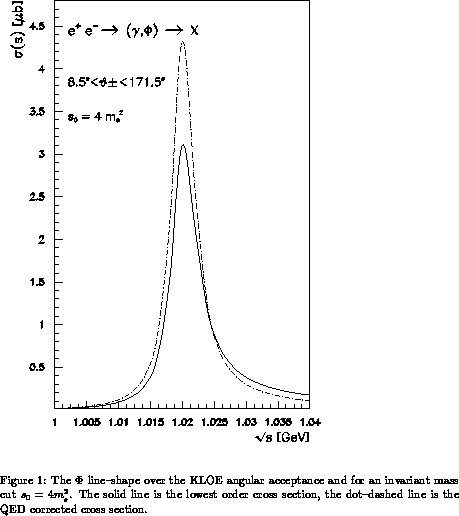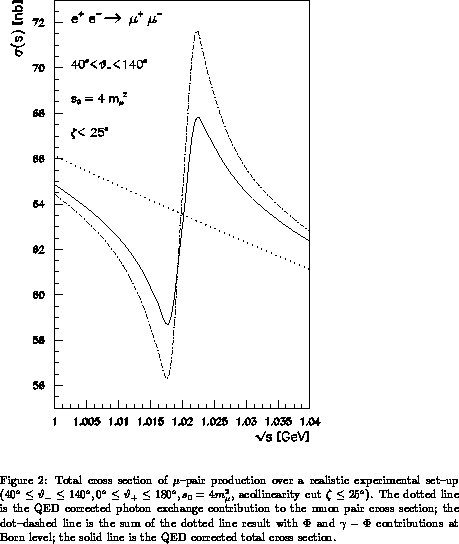
Computing QED corrections over a realistic set--up is a much more involved problem, since the corrections, besides being large, critically depend on the experimental cuts such as energy or invariant mass thresholds, angular acceptance, acollinearity cut and so on. In this case, the structure function approach allows to write the corrected cross section in the laboratory frame in the following form [2,3]:
where the angular integration has to be understood as follows:

with  and
and  the azimuthal and polar angle of the scattered
fermion. Here we limit ourselves to give a general description of
eq. (17). For more details and explicit formulae the
reader is referred to [2,3].
the azimuthal and polar angle of the scattered
fermion. Here we limit ourselves to give a general description of
eq. (17). For more details and explicit formulae the
reader is referred to [2,3].  stands for the portion of the
stands for the portion of the  initial state radiation phase space
allowed by realistic cuts; it can be analytically delimited by solving
the kinematics of the hard scattering process in the presence of
initial state radiation if one assumes
soft and/or collinear approximation
and hence derives the limits on the
initial state radiation phase space
allowed by realistic cuts; it can be analytically delimited by solving
the kinematics of the hard scattering process in the presence of
initial state radiation if one assumes
soft and/or collinear approximation
and hence derives the limits on the  variables
imposed by realistic cuts.
variables
imposed by realistic cuts.
 is the Jacobian of the
transformation from the centre of mass to the laboratory frame and accounts
for the boost caused by the emission of unbalanced radiation by
the initial state radiation.
In the ultrarelativistic approximation its expression reads:
is the Jacobian of the
transformation from the centre of mass to the laboratory frame and accounts
for the boost caused by the emission of unbalanced radiation by
the initial state radiation.
In the ultrarelativistic approximation its expression reads:

The photonic content of the structure function  can be directly read by its explicit expression [6]:
can be directly read by its explicit expression [6]:

which one obtains by solving, according to well--established
techniques [6],
the Lipatov -- Altarelli -- Parisi evolution equation satisfied by  in terms of the one--loop expression for the splitting function
in terms of the one--loop expression for the splitting function
 . This allows to
resum large mass logarithms from soft multiphoton
emission and to include hard photon effects up to
. This allows to
resum large mass logarithms from soft multiphoton
emission and to include hard photon effects up to  .
In the K-factor
.
In the K-factor  one reabsorbs next--to--leading
contributions matching the perturbative results for
the specific process under consideration.
one reabsorbs next--to--leading
contributions matching the perturbative results for
the specific process under consideration.

 provides the final state QED correction
to the cross section in the presence of realistic experimental cuts. Its
provides the final state QED correction
to the cross section in the presence of realistic experimental cuts. Its
 analytic
expression is known but it is too lengthy to be displayed here
and can be found in [9]. It should be emphasized that in a realistic
set--up higher order final state corrections could
become relevant pointing out the
need of introducing a resummation procedure of large
logarithms. A detailed discussion about different
prescriptions for treating higher order final state effects
is given in [2,3]. Moreover, when considering
final state corrections to Bhabha
scattering, one is also faced with the problem of the
calorimetric measurement
for electrons since what is detected is an
electromagnetic jet of semi--aperture
analytic
expression is known but it is too lengthy to be displayed here
and can be found in [9]. It should be emphasized that in a realistic
set--up higher order final state corrections could
become relevant pointing out the
need of introducing a resummation procedure of large
logarithms. A detailed discussion about different
prescriptions for treating higher order final state effects
is given in [2,3]. Moreover, when considering
final state corrections to Bhabha
scattering, one is also faced with the problem of the
calorimetric measurement
for electrons since what is detected is an
electromagnetic jet of semi--aperture  ,
where
,
where  is an
experimental parameter describing the resolution power of the calorimeter.
In our approach this effect is accounted for by adding
to the
is an
experimental parameter describing the resolution power of the calorimeter.
In our approach this effect is accounted for by adding
to the  part of the final state QED correction the contribution due to
the emission of an hard photon with an
energy fraction greater than 1-x, where x is
part of the final state QED correction the contribution due to
the emission of an hard photon with an
energy fraction greater than 1-x, where x is  for an invariant mass cut and
for an invariant mass cut and  for
an energy threshold cut, and collinear
with the final fermion within
an angle
for
an energy threshold cut, and collinear
with the final fermion within
an angle  .
For high--energy electrons the contribution reads [10]
.
For high--energy electrons the contribution reads [10]
where

Eq. (21) is valid in the approximation  rad
and
rad
and  which is safely satisfied at DA
which is safely satisfied at DA NE energies.
NE energies.
The master formula (17) needs further manipulations in order to extract numerically stable and fast predictions. Indeed this expression as it stands exhibits several computational problems which can be solved by an appropriate regularization procedure, described in detail in [3], namely the variance--reducing technique known as ``control variates''. Then the corrected cross section can be written as the the sum of an analytical term, of a one--dimensional integral in the radiator form (containing the bulk of the whole contribution) and terms with one--, two-- and three--dimensional integrals controlling the angular and acollinearity effects which, albeit important, are generally a small contribution as compared with the effect due to an invariant mass cut alone. The above regularization procedure is implemented in the FORTRAN program for electroweak physics at LEP/SLC energies TOPAZ0 [11].
A few comments are in order here about the accuracy of the
theoretical predictions derivable from eq. (17)
for resonant and non resonant hard scattering processes
measured over a realistic set--up.
Actually, it should be noted that, whereas any  large
angle process (including Bhabha scattering) at LEP/SLC energies
is a resonant process with small non--resonant contributions,
this is not the case of leptonic production at DA
large
angle process (including Bhabha scattering) at LEP/SLC energies
is a resonant process with small non--resonant contributions,
this is not the case of leptonic production at DA NE. As a
consequence, non leading contributions not included in our approach
(initial state hard photon constant terms and initial--final state
interference)
are almost negligible (of order, say, few
NE. As a
consequence, non leading contributions not included in our approach
(initial state hard photon constant terms and initial--final state
interference)
are almost negligible (of order, say, few  )
only for the case of the
)
only for the case of the  line--shape where the
above effects are strongly suppressed by the very narrow width of
the
line--shape where the
above effects are strongly suppressed by the very narrow width of
the  resonance. This argument obviously does not apply to
non--resonant processes
resonance. This argument obviously does not apply to
non--resonant processes  at DA
at DA NE
and therefore the theoretical error, depending on the cuts, becomes
larger (presumably of order of a few per cent) and the predictions have to
be understood (especially for Bhabha scattering) as leading log ones.
NE
and therefore the theoretical error, depending on the cuts, becomes
larger (presumably of order of a few per cent) and the predictions have to
be understood (especially for Bhabha scattering) as leading log ones.
Illustrative numerical results are given in Fig. 1 ( line--shape)
and Fig. 2 (muon pair cross section) obtained by fitting the program
TOPAZ0 to DA
line--shape)
and Fig. 2 (muon pair cross section) obtained by fitting the program
TOPAZ0 to DA NE processes. Fig. 1 shows the lowering of the
peak cross section (of order
NE processes. Fig. 1 shows the lowering of the
peak cross section (of order  ) essentially due soft multiphoton
emission and the radiative tail above the peak as a typical
convolution hard photon effect. Fig. 2 shows the effects of the QED
radiative corrections on the
cross section for muon pair production
when a realistic experimental set--up is considered.
) essentially due soft multiphoton
emission and the radiative tail above the peak as a typical
convolution hard photon effect. Fig. 2 shows the effects of the QED
radiative corrections on the
cross section for muon pair production
when a realistic experimental set--up is considered.
